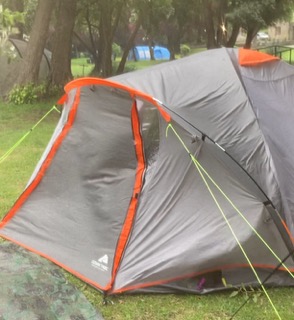This post contains affiliate links.
I always felt confident with my camping ability until August this year. After lockdown ended, we booked a 3-day camping break.
As our few days break got closer, we soon realized that we would be camping during a hurricane. With help from an extreme camper and personal experience, we managed to keep our 4 man dome tent standing. However, it did feel that our tent would collapse at any moment.
Tents can withstand up to 30mph, so during high winds, you should use your natural environment to help create a shelter and not set your pitch in the middle of open ground. Use all of your guy ropes and double peg individually whilst pointing the lowest section of your tent into the wind. Cover your tent with a strong tarp, increasing the strength and waterproofing your tent whilst closing all windows and doors to avoid your tent from taking off.
Do tents have wind resistance ratings?
Tents do not have wind resistance ratings. It is crucial to look at the other features available if you are camping in areas with high wind.
- Season 3 and 4 tents are designed for the harsher weather
- Heavier material
- More guy loops and points
- More poles that are stronger
- Full-size fly that is close to the floor to stop the wind from coming under it
- Aerodynamic design that allows wind to go around and flow over the tent without much resistance
Follow your tent instructions for pitching
All tents are designed differently; each design is unique. You must follow the instructions provided fully.
Tents poles are colour-coded and replicated on tent tabs that identify where you need to thread the pole.
Using natural environment for shelter
When choosing the ideal location to pitch your tent, look at the surrounding environment. Ideally, pitch your tent near a natural shelter that will provide you with a natural windbreaker. Ideally, these should be hedges, bushes, or low trees that offer a shield and protection.
Don’t pitch directly under trees, as branches can fall and cause damage or injury to your tent or yourself. When you locate a natural shield, slowly walk away to judge the best distance to pitch your tent and how much natural shelter will be provided.
Normally in heavy wind it is combined with rain. Read our article on how to pitch your tent in the rain without getting the inside soaking wet.
Pitch your tent so the lowest section is facing the wind
The lowest section or the bum end of your tent should be facing the wind direction. Allowing the wind to flow over your tent, reducing pressure and broken poles due to the force of the wind bearing down.
Pitch your tent, so the wind does not hit the sides. The wind will place pressure on your poles, and they will bend out of their natural arch, which will snap or weaken them.
How to secure your tent before pegging in high wind
There is nothing worse than trying to hold a tent down and peg in high winds. Before you lay your tent out, ready to erect, look for any rocks that you can layer onto your tent to hold in place.
Make sure that they will not damage your tent.
Gradually unroll your tent, placing the rocks at the corners edges to stop the wind from blowing your tent. I also place rocks in the centre of the tent for additional support.
If you cannot find rocks, check the camping equipment you have with you. Is there anything you can use instead? For instance, a freezer box, food containers or bags.
If you are laying a groundsheet first to protect your tent base, use rocks to secure it first.
How to secure round wire pegs for gusty weather
Tents are supplied with standard round wire pegs, which, to be honest, will not keep your guy lines secure in high winds or wet soft ground. If you do not want to invest in extra pegs, use two for one guy ropes and cross the top hooks over each other to help secure your guy ropes in lousy weather.
Whether they are placed individually or two pegs crossed over each other, you will need to keep checking that they are still secure in the ground. Keep your mallet handy, as you will need to keep tapping them back into the ground.
They are cheap and nasty, so invest in more effective pegs as soon as you can. Delta ground anchors are ideal as they are super nylon composite that sits flush to the ground, which reduces trip hazards. But they are suitable for all types of ground.
What angle should my tent pegs be?
If you place your pegs directly into the ground straight, they will pull out and not secure your guy ropes.
Peg the four corners of your tent first. These pegs would be at 45 degrees angle and deep into the ground. They need to be angled away from your tent, not towards your tent; otherwise, any gusty wind will pick up your tent.
Make sure you use all of your pegs, don’t skip.
Using guy ropes supplied and angles with your tent
To secure your tent, you must use all of your guy ropes. Do not skimp on this, as this will help keep your tent secure. Place your guy ropes, so they have no slack, but not so it causes your tent to be taunt, as it will tear.
Most tents have velcro wrap that you can use to add additional support. Once your guy ropes pegged, wrap the velcro around the pole, adding extra security.
If you need additional guy ropes, you can easily replace your current ones. Luminous guy ropes are an ideal replacement as they will reduce the risk of tripping. The more guy ropes you use, the more secure your tent will be and reduce your tent’s damage due to tension.
Use two pegs per guy rope

Instead of using one peg to secure your guy rope in gusty weather, use two pegs and place them horizontal to each other. Each peg secures a section of the guy rope.
Pull the guy rope at a 30-60 degree angle from your tent, and using both pegs, secure your line. If you only have the round wire pegs, use two per corner and cross the hook sections over.
How to provide additional support to poles and pegs
Rocks and large stones can provide additional support to poles. Place these around the base of your poles and pegs.
Although stones are ideal for support, if you do not have perfect pegs, place heavier rocks on top of your pegs to keep them in the ground.
Additional tarp can protect your tent
Using an additional strong tarp will add protection to your tent. Placing the tarp over your tent entirely and ensuring it is pegged securely will help protect against gusty weather and help keep your tent waterproof.


